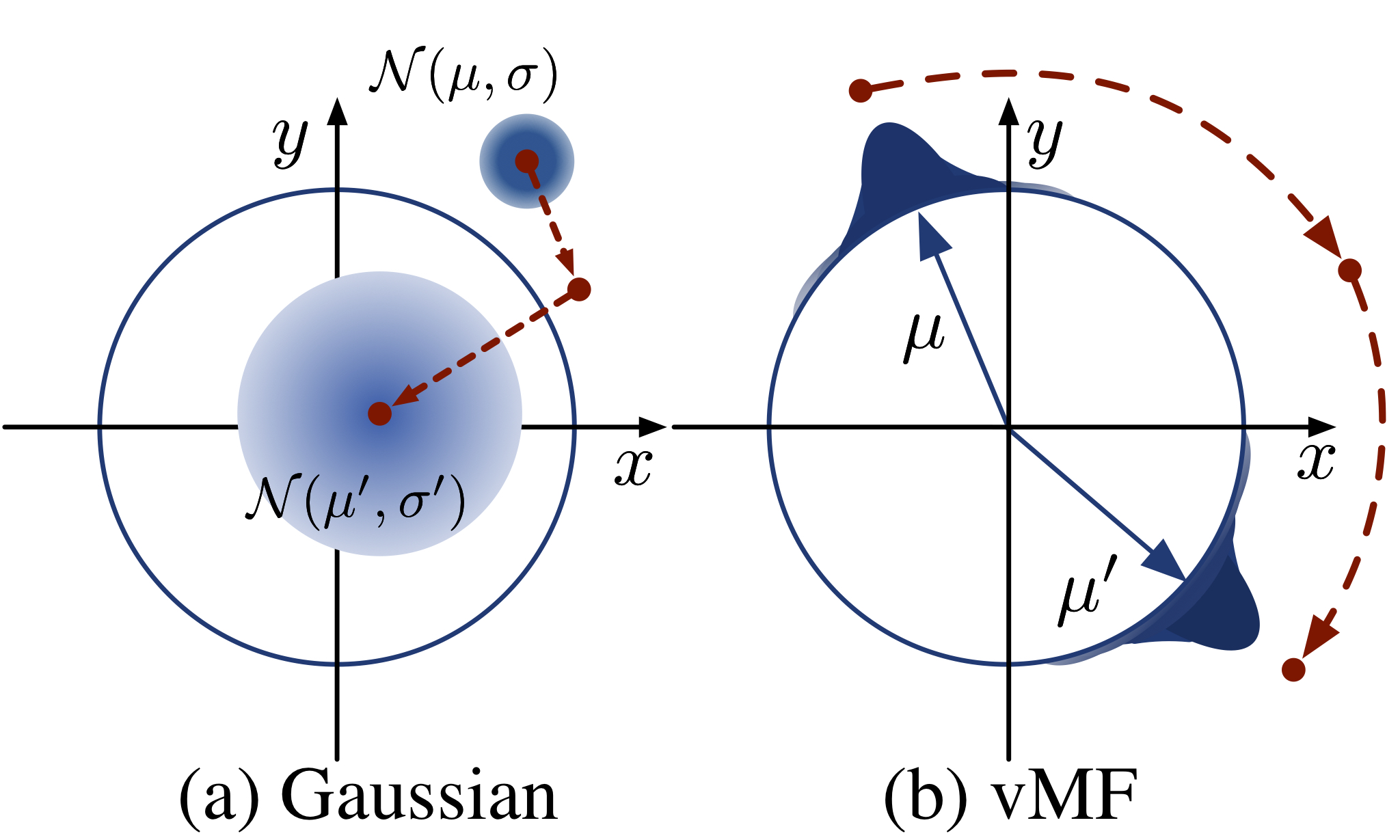jiacheng-xu / Vmf_vae_nlp
Programming Languages
Projects that are alternatives of or similar to Vmf vae nlp
Spherical Latent Spaces for Stable Variational Autoencoders (vMF-VAE)
In this repo, we provide the experimental setups and implementation for the algorithms described in:
Spherical Latent Spaces for Stable Variational Autoencoders.
Jiacheng Xu and Greg Durrett. EMNLP 2018.
Author: Jiacheng Xu and Greg Durrett.
The arXiv version has been posted: arXiv.
About
Keyword: PyTorch, VAE, NLP, vMF
What to get from this repo:
- Original Gaussian VAE;
- Novel von-Mises Fisher VAE (vMF-VAE) with tuned hyper-parameters.
Illustration
Optimization

Figure: the visualization of optimization of how q varies over time for a single example during learning.
- Gaussian: the KL term tends to pull the model towards the prior (moving from μ,σ to μ′,σ′);
- vMF: there is no such pressure towards a single distribution. If we fix the dimension and the kappa, the KL term is a constant in the optimization objective.
Comparison of the Model
 Figure: the model architecture. The left one is Gaussian and the right one is vMF. More details in the paper.
Figure: the model architecture. The left one is Gaussian and the right one is vMF. More details in the paper.
Setup
The environment base is Python 3.6 and Anaconda.
The codes are originally developed in PyTorch 0.3.1 and upgraded to PyTorch 0.4.1.
conda install pytorch=0.4.1 torchvision -c pytorch
pip install tensorboardX
Data
Data for Document Model
In this paper, we use the exact same pre-processed dataset, 20NG and RC, as Miao et al. used in Neural Variational Inference for Text Processing. Here is the link to Miao's repo.
- Download RC (Email me or submit an issue if it doesn't work)
- Location of 20 News Group(20ng):
data/20ng.
Data for Language Model
We use the standard PTB and Yelp. Datasets are included in data.
Running
Set up Device: CUDA or CPU
The choice of cpu or gpu can be modified at NVLL/util/gpu_flag.py.
Explanation of Options & Arguments
If you want to play around with the {Gaussian, vMF} VAE model for {document model, language model}, there are many possible settings.
You can pass command-line arguments and the NVLL/argparser.py will handle the arguments. I will explain some nontrivial arguments.
| Option | Usage | Value (Range) |
|---|---|---|
| dist | which distribution to use | {nor, vmf} |
| lat_dim | dimension of the latent variable | Int |
| kl_weight | the weight term before KL term in the objective funtion | 1 (default), any |
| exp_path | The location for exp logs and saving files. | YOUR/EXP |
| root_path | The location of the git repo. data is a sub-dir. | YOUR/vmf_vae_nlp |
| ---- | Args Below Only availble for NVRNN | ---- |
| input_z | Input the latent code z at every time step during decoding | True (default) or False |
| mix_unk | How much of the input is mixed with UNK token. 0 = Using ground truth as input (Standard setting) and 1 = Using UNK as input (Inputless setting) | [0.0, 1.0] |
| cd_bow | Condition on Bag-of-words. 0=not conditioned on BoW. | 0 or int(like 200). |
| cd_bit | Condition on sentiment bit for the Yelp dataset. Not available for PTB. 0=not conditioned on sentiment bit. | 0 or int(like 50). |
Train and Test
See here for hyper-parameter configuration.
Training Neural Variational Document Model (NVDM)
cd NVLL
# Training vMF VAE on 20 News group
PYTHONPATH=../ python nvll.py --lr 1 --batch_size 50 --eval_batch_size 50 --log_interval 75 --model nvdm --epochs 100 --optim sgd --clip 1 --data_path data/20ng --data_name 20ng --dist vmf --exp_path YOUR/EXP --root_path YOUR/vmf_vae_nlp --dropout 0.1 --emsize 100 --nhid 400 --aux_weight 0.0001 --dist vmf --kappa 100 --lat_dim 25
# Training vMF VAE on RC
PYTHONPATH=../ python nvll.py --lr 1 --batch_size 50 --eval_batch_size 50 --log_interval 1000 --model nvdm --epochs 100 --optim sgd --clip 1 --data_path data/rcv --data_name rcv --dist vmf --exp_path YOUR/EXP --root_path YOUR/vmf_vae_nlp --dropout 0.1 --emsize 400 --nhid 800 --aux_weight 0.0001 --dist vmf --kappa 150 --lat_dim 50
Training Neural Variational Recurrent Language Model (NVRNN)
cd NVLL
# --cd_bow 200
# Condition on BoW
# --cd_bow 0
# NOT Condition on BoW. Default setting
# --cd_bit 50
# Condition on sentiment bit. Only for Yelp.
# --cd_bit 0
# Not Condition on sentiment bit. Only for Yelp. In this case, sentiment bit will be skipped. Default Setting.
# --swap 0.0 --replace 0.0
# Default setting. No random swapping of encoding sequence.
# Training vMF VAE on PTB
# Example
PYTHONPATH=../ python nvll.py --lr 10 --batch_size 20 --eval_batch_size 20 --log_interval 500 --model nvrnn --epochs 100 --optim sgd --data_name ptb --data_path data/ptb --clip 0.25 --input_z --dropout 0.5 --emsize 100 --nhid 400 --aux_weight 0 --nlayers 1 --swap 0.0 --replace 0.0 --exp_path YOUR/EXP --root_path YOUR/vmf_vae_nlp --cd_bit 0 --cd_bow 0 --dist vmf --kappa 80 --mix_unk 1 --lat_dim 50 --norm_max 1
# Training vMF VAE on Yelp
PYTHONPATH=../ python nvll.py --lr 10 --batch_size 20 --eval_batch_size 20 --log_interval 500 --model nvrnn --epochs 100 --optim sgd --data_name ptb --data_path data/ptb --clip 0.25 --input_z --dropout 0.5 --emsize 100 --nhid 400 --aux_weight 0 --nlayers 1 --swap 0.0 --replace 0.0 --exp_path YOUR/EXP --root_path YOUR/vmf_vae_nlp --cd_bit 50 --cd_bow 0 --dist vmf --kappa 80 --mix_unk 0 --lat_dim 50 --norm_max 1
Reference
Please cite:
@InProceedings{xu2018,
author = "Xu, Jiacheng and Durrett, Greg",
title = "Spherical Latent Spaces for Stable Variational Autoencoders",
booktitle = "Proceedings of the 2018 Conference on Empirical Methods in Natural Language Processing",
year = "2018",
}
For other implementation of vMF VAE, please refer to
- Kelvin Guu's repo and paper.
- Tim R. Davidson's repo (TensorFlow), repo (PyTorch), paper and Supplementary material
Contact
Submit an issue here or find more information in my homepage.
